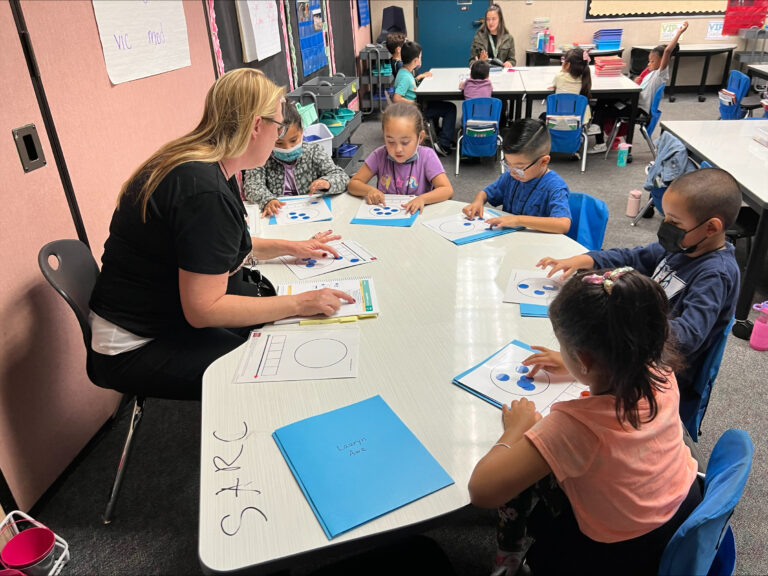Spotlight California: Driving momentum for systemic literacy change
Val Verde Unified School District is the smaller of two districts in Riverside County, California, and is located southeast of Los Angeles, serving approximately 20,000 students across 21 schools. Schools in Val Verde were facing several challenges in improving student reading outcomes and have been on a journey to strategically implement science of reading practice in their classrooms for a number of years. Val Verde’s journey highlights the importance of evidence-based, data-driven instruction, ongoing support, and a commitment to equitable education for all students.

District Snapshot:
- 20,000 students in 21 schools
- ~80% hispanic population
- ~80-85% students receive free and reduced lunch
- ~20% ELL
- ~11-12% SpEd
Student literacy support needs a data-driven approach
When moving students from a Student Support Team (SST) model into an Response To Intervention or RTI (now referred to as Multi-Tier Support System or MTSS) model, the typical path at Val Verde Unified School District—as with many other school systems—was to provide IEP-determined accommodations and modifications within a teacher’s classroom and curriculum. These might have included things like preferential seating, proximity to teacher or the board, extra time for assessment or assignment, or modification of assignments depending on a student’s needs.
A few years ago, district leaders at Val Verde realized that perhaps what these students actually needed was a more data-driven approach to their learning support. They began using DIBELS, a universal literacy screener; but were at a loss for what to do with all of the data they collected.
When Jessica Warren, Coordinator of Elementary Education at Val Verde, reached out to a colleague for resources, he gave her the influential book by Susan L. Hall, EdD, Implementing Response to Intervention: A Principal’s Guide (Corwin, 2007). Reading this book by Dr. Hall, cofounder of 95 Percent Group, led Val Verde right to 95 Percent Group and their literacy intervention products.
Prevention + intervention lifts all students
As literacy leaders and teachers at some Val Verde schools began implementing Tier 2 Intervention solutions like the 95 Phonics Screener for Intervention™ (95 PSI), 95 Phonics Chip Kit™ (PCK™) and the 95 Phonics Lesson Library™ (PLL™) in more classrooms, it pulled back the curtain on some of the gaps they hadn’t seen before. They gained clarity on what was sitting underneath their students’ Tier 2 challenges in reading. Still the progress they were making with their struggling students was impressive, so they continued on that path.
“95 Percent Group was opening up possibilities,” Aimee Garcia, K-12 director of education services for the district, implored. “We realized: here’s this evidence-based practice where we’re seeing a lot of research. It’s very scripted, and very easy to use—let’s start being more targeted with these products.”
Eventually as they watched their students make progress quickly with 95 Percent Group’s Tier 2 products, they realized that they didn’t necessarily have an intervention problem. What they had was a literacy curriculum that hadn’t been implemented with fidelity and that wasn’t moving enough students toward grade-level success. They decided to step back and figure out what teachers needed in order to have equitable implementation of the Tier 1 reading curriculum across classrooms and schools. “We had the 95 Percent Group products here already,” Garcia explained. “But we needed to systemize it.”
While they acknowledged that this was a difficult decision to make, district leaders knew that in order to enact change within the whole system, they had to make sure their Tier 1 curriculum instruction was their “first best instruction.” If students weren’t getting their first best instruction until they needed intervention, then something wasn’t right.
Garcia said, “We started responding to the intervention data, but also asking the question: How does this connect back to Tier 1? Can we be responsive and preventative by doing two things at the same time?”
Read more
Leaders and educators at Val Verde Unified School District were able to see that two things were true: 1) they needed to systemize Tier 2 intervention, and 2) they needed to support their teachers with ongoing learning and coaching in order to ensure everyone was on the same page across all classrooms and all schools in the district. Interesting in learning how they tackled both challenges?
Click the button below to download the full story and learn about their solution for systemwide literacy change!



